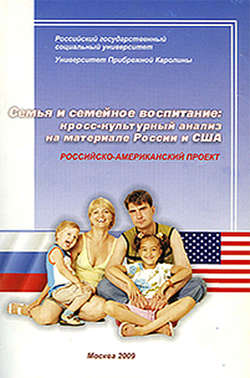Читать книгу Семья и семейное воспитание: кросс-культурный анализ на материале России и США - Коллектив авторов - Страница 18
Влияние социальной поддержки семьи на здоровье ее членов
Литература
Оглавление1. Adams-Campbell, L, Rosenberg, L, Washburn, R., Rao, R., Kim, K, & Palmer, J. (2000). Descriptive epidemiology of physical activity in African-American women. Preventive Medicine, 30, pp. 43–50.
2. Centers for Disease Control and Prevention [CDC]. (1997). Youth Risk Behavior Surveillance: National College Health Risk Behavior Survey-United States, 1995. MMWR; 46 (No. SS-6).
3. Covey, L, & Feltz, D. (1991). Physical activity and adolescent female psychological development. Journal of Youth and Adolescence, 20(4), pp. 463–474.
4. Davidson, K. (2004). Activity-related support from parents, peers, and siblings and adolescents’ physical activity: Are there gender differences? Journal of Physical Activity and Health, l,pp. 363–376.
5. Dillman, D. (2000). Mail and internet surveys: The tailored design method. New York: John Wiley & Sons.
6. Kahn R.L., Antonucci I (1980). Convoys over the life course: Attachment, roles and social support. In Life-Span Development and Behavior, ed. PB Baltes, J. Orville G. Brim, pp. 253–286. New York: Academy Press
7. Kimm, S., Glynn, N., Kriska, A., Barton, B., Kronsberg, S., Daniels, S., et al. (2002). Decline in physical activity in Black girls and White girls during adolescence. The New England Journal of Medicine, 347(10), pp. 709–715.
8. Kolbe, К, Kann, К, Patterson, В., Wechsler, Н., Osorio, J. & Collins, J. (2004). Enabling the Nations’s Schools to help prevent heart disease, stroke, cancer, COPD, diabetes, and other serious health problems. Public Health Reports, 119(3), pp. 286–302.
9. Leonard, W (2001). Assessing the influence of physical activity onhealth and fitness. American Journal of Human Biology, 13, pp. 159–161.
10. MacKay, A., Fingerhut, L., & Duran, C. (2000). Adolescent Health Chartbook. Health, United States. National Center for Health Statistics: Hyattsville, MD.
11. McGinnis, J., & Foege, W (1993). Actual causes of death in the United States. Journal of the American Medical Association, 270(18), pp. 2207–2211.
12. Mellin, A., Neumark-Sztainer, D., Story, M., Ireland, M., & Re snick, M. (2002). Unhealthy behaviors and psychosocial difficulties among overweight adolescents: The potential impact of familial factors. Journal of Adolescent Health, 31, pp. 145–153.
13. Melnyk, G., & Weinstein, E. (1994). Preventing obesity in Black women by targeting adolescents: A literature review. Journal of the American Dietetic Association, 94(5), pp. 536–540.
14. Mokdad, A., Marks, J., Stroup, D., & Gerberding, J. (2004). Actual causes of death in the United States, 2000. Journal of the American Medical Association, 291(10), pp. 1238–1245.
15. Mokdad, A., Marks, J., Stroup, D., & Gerberding, J. (2005). Correction: Actual causes of death in the United States, 2000. Journal of the American Medical Association, 293(3), pp. 293–294.
16. Parnell, K, Sargent, R., Thompson, S., Duhe, S., Valois, R., & Kemper, R. (1996). Black and White adolescent females’ perceptions of ideal body size. Journal of School Health, 66(3), pp. 112–118.
17. Sallis, J., Grossman, R., Pinski, R., Pattersoh, I, & Nader, PP. (1987). The development of scales to measure social support for diet and exercise behaviors. Preventive Medicine, 16, pp. 825–836.
18. Sarason, B., Sarason, L, & Pierce, G. (1990a). Social support: An interactional view. New York: John Wiley & Sons.
19. Sarason, B., Sarason, L, & Pierce, G. (1990b). Social support: The search for theory. Journal of Social and Clinical Psychology, 9(1), pp. 133–147.
20. Sarason, L, Levine, H., Basham, R., & Sarason, B. (1983). Assessing social support: The social support questionnaire. Journal of Personality and Social Psychology, 44(1), pp. 127–139.
21. Teiljohann, S., Symons, C. & Pateman, B. (2007). Health Education: Elementary and middle school applications. McGraw Hill: New York, NY.
22. Trost, S., Pate, R., Saunders, R., Ward, D., Dowda, AT, & Felton, G. (1997). A prospective study of the determinants of physical activity in rural fifth-grade children. Preventive Medicine, 26, pp. 257–263.
23. U. S. Department of Health and Human Services. (2004). Physical activity and good nutrition: Essential elements to prevent chronic disease and obesity. Centers for Disease Control. Atlanta, GA: Author.
24. U.S. Department of Health and Human Services and U.S. Department of Agriculture. (2005). Dietary guidelines for Americans (6th ed.). U.S. GPO, Washington, DC: Author.
25. U.S. Department of Health and Human Services. (2000). Healthy People 2010 (Conference Edition, in Two Volumes). Washington, DC.
26. Walcott-ALcQuigg, J., Zerwic, J., Dan, A., & Kelley, AT. (2001). An ecological approach to physical activity in African American women. Medscape Women’s Health eJoumal, 6(6). Retrieved September 14, 2002, from http://www.medscape.com/viewarticle/415128.
27. Wechsler, H., Brener, N., Kuester, S., & ALiller, C. (2001). Food service and foods and beverages available at school: Results from the school health policies and programs study 2000. Journal of School Health, 71(7), pp. 313–324.
Перевод с английского А.Ю. Васильевой
